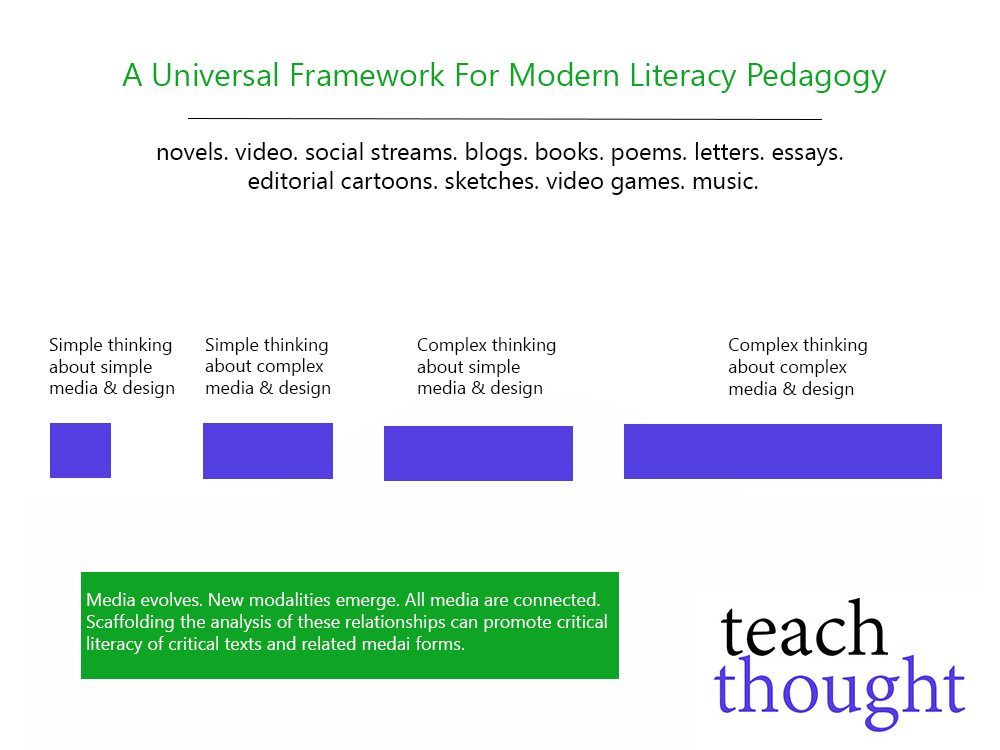
A Framework For Merging Classic Literature & Modern Technology
by Terry Heick
Why do we need a framework?
Literacy instruction has done a relatively poor job of keeping up with the urgent pace of change in the ways people read and write.
What’s the big idea?
Media evolves. New modalities emerge. All media are connected. Scaffolding the analysis of these relationships can promote critical literacy of critical texts and related media forms. This can serve as a foundation for modern literacy.
Quick Background
The forms most commonly used to communicate (texts, emails, music, articles, video, and film) have increased the quantity of communication. (The cost to quality is subjective, but worth examining further.)
This may be creating a delineation between the “old” (e.g., a novel or poem or essay) and the “new” (e.g., an interactive graphic novel or tweet or video stream). Further, this obscures the connection that exists between all media forms–they all represent the need for humans to communicate–to hear others, and be heard themselves. As technology increases the tools available to meet this need, the communicate patterns may continue to become more nuanced and distinct. This risks cultural devaluation of that which is seen as “old” and unfamiliar.
A Definition for Modern Literacy: The ability to both create and extract communication through prevailing local media forms
A Definition for Modern Literacy Pedagogy: Helping students create and extract communication through prevailing local media forms
Media (plural form of medium): The forms we use as a culture to communicate ideas
Examples of “media forms”: novels. video. social streams. blogs. books. poems. letters. essays. editorial cartoons. sketches. video games. music. paintings.
What about the simple…complex part?
The idea of the simple thinking about simple media–>complex thinking about complex media spectrum is to first and foremost, make the analysis of any media form accessible in some way, shape, or form. Students needn’t be pushed to ‘think critically’ about media forms–or their inherent themes–without being given strategies and practice to do so.
What are modalities?
Modalities are the unique methods a given media communicates ideas.
The modalities of drama/plays include: stage presence, dialogue patterns, language, music, scenery, etc.
The modalities of poem include: line breaks, imagery, figurative language, etc.
The modalities of a video game include: music, a digital avatar, light, a clear narrative, a character’s interactions with a hostile environment, etc.
The media form–in terms of its structure and modalities–is decentered in this framework. The focus is on the interpretation of the symbols–modalities of light and color and sound and text and moving image, for example–to clarify an author’s message, and then taking a tiered approach to extracting any complexity within.
In short, this is about seeing literacy as symbol decoding, seeing those symbols as modalities, and scaffolding the analysis of it all as a matter of medium/media design.
Stage 1: Simple think about simple media design
Example: In Looney Tunes, why does Wile E. Coyote chase the Road Runner?
Stage 2: Simple thinking about complex media design
Example: How do characters communicate in Shakespearean plays?
Stage 3: Complex thinking about simple media design
Example: What might we infer about Wile E. Coyote’s own interpretation of cultural norms? How does he adapt–or refuse to adapt–those norms through his observable behavior?
Stage 4: Complex thinking about complex media design
Example: How does Shakespeare use diction to establish a unique tone within each individual scene, and how do those scenes collectively establish a theme for the plays themselves?
A Handful of Underpinning Ideas
- Literacy is a matter of decoding, comprehension, and transfer.
- The traditional media forms of books, poems, letters, and speeches is increasingly supplemented by diverse and technology-based media.
- There is a clear and direct relationship between a poem, an essay, a tweet, and a video game.
- Understanding that relationship can help leverage modern digital technology and forms to interpret classical structures, and vice-versa.
- Scaffolding the analysis of these forms and structures can make anything more approachable.
- It can also provide opportunities for differentiation, self-directed learning, and extended critical thinking about critical media.
A Framework For Merging Classic Literature & Modern Technology; A Universal Framework For Modern Literacy Pedagogy